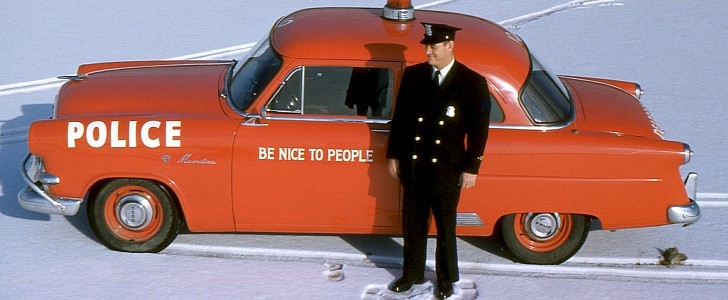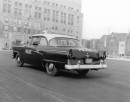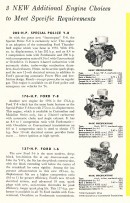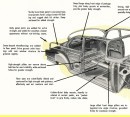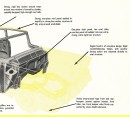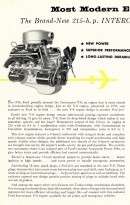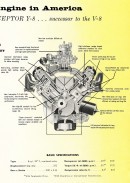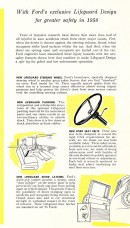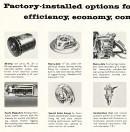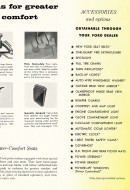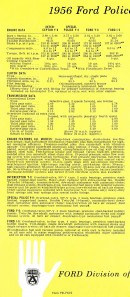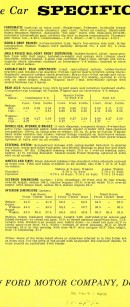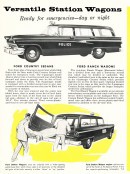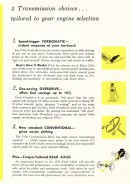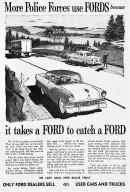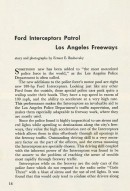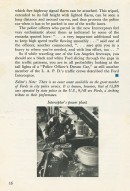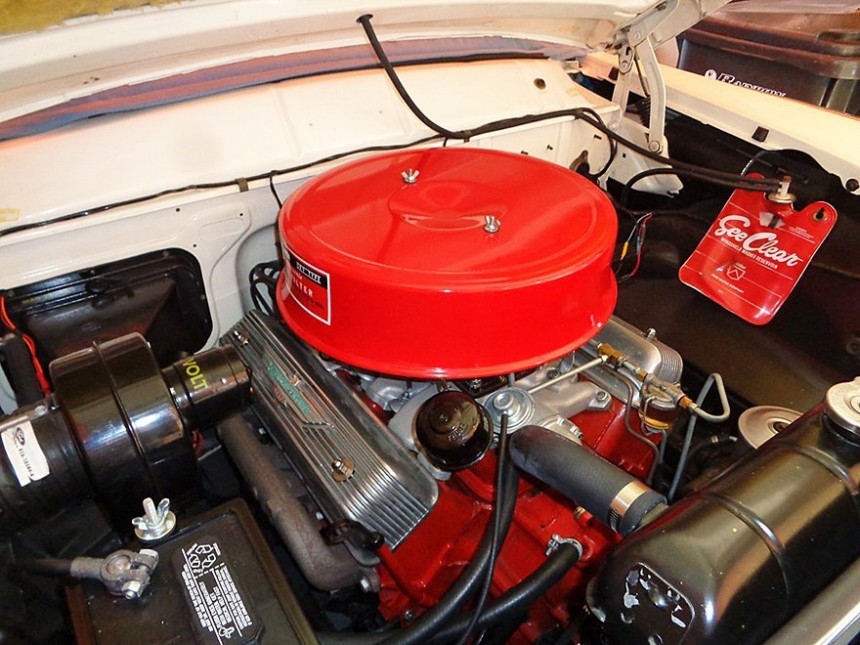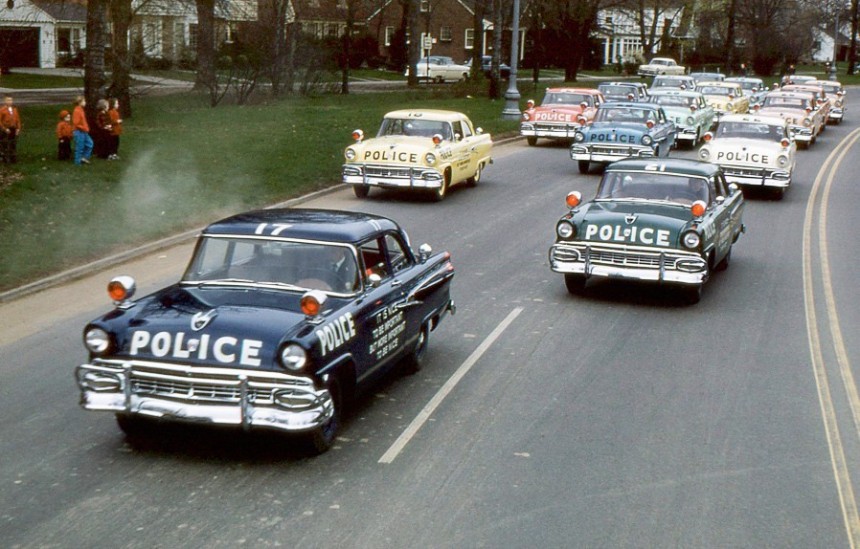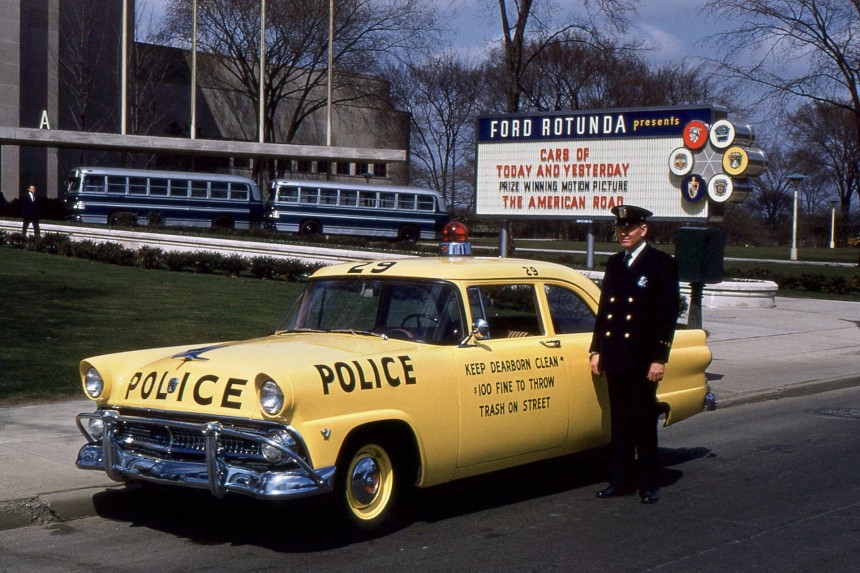In all honesty, we don't see many car commercials advertising special utility vehicles, like police cars, to the general public. However, in 1956, marketing and publicity standards were a little different, and Ford took great pride in equipping law enforcement with the horsepower to suit their needs.
Since, back then, television was the top-of-the-heap choice to reach vast audiences, the guys From Dearborn, Michigan, spared no expense to boast about the contribution of the Blue Oval for the boys in blue.
It is a neat publicity stunt to have the badge of an automobile maker stamped with "Police" decals, especially if those cars are fast and reliable, which is precisely what Ford was advertising through its law-enforcing automobiles.
The police cars had to be tough to endure the ordeals of prolonged usage under rough conditions. When we talk about special-purpose vehicles, we think of some performance – in this case, speed was the main attribute of the police cars (in Ford's opinion).
The new top-of-the-range optional Interceptor Y-8 – dubbed by copywriters as the "Most Modern Engine" – was quite impressive in specs for its time. Specially designed to equip the Police and Emergency vehicles of Ford make, the 312 CID (5.1 liters) "deep-block" could output 215 hp and 317 lb-ft of torque (430 Nm) – when equipped with the Ford-O-matic transmission (which was a three-speed automatic).
The other two options were either Conventional three-speed manual drive or Overdrive – also manual, but with an auto fourth-speed overdrive gear - had the less powerful plant, which gave out 210 hp and 312 lb-ft (423 Nm).
The four-barrel carburetor with integral choke and complete twin exhaust system gave the engine "rapid acceleration and high speeds." The extra two barrels on the carburetor had a distinct feature: "are brought into use by the engine's needs, not by the gas pedal position."
Introduced by Ford in 1954, the Y-shaped V8 had several other technological attractions: the turbo-wedge combustion chambers (check the second video to see another TV commercial about those), three-piece oil rings with chromed-steel segments, high-lift camshaft, free-turning overhead valves, or 18 mm anti-fouling spark plugs.
Also, a special factory-built, factory-sold, but not factory-installed High Power Engine Kit – a "special-order high-performance parts to modify the 312-CID engine for police" churned 260 hp. Ford took such great pride in giving their engine power to the Force that they built a special police car engine called (you're not going to believe it!) "Special Police."
This motor was the standard plant for all police Ford cars of 1956. Slightly less potent than the Interceptor, the Special Police was a 292 CID (4.8-liter) V8 with two different transmission-dependent outputs. Both manual gearboxes (the three-speed Conventional and four-speed Overdrive) got 200 hp, 285 lb-ft (Nm). The three-speed automatic Fordormatic benefitted from two extra hp and four extra lb-ft of torque, reaching a 202 hp power figure and 289 lb-ft (392 Nm).
The police cars of the 1956 model year and Ford provenance weren't all about speed and power – although the TV commercial in the video below seems to hint at those traits primarily. Safety was also a significant trait that the motoring company bragged about – and we mean car occupants' safety. Don't think of some bullet-proofing or any other special equipment destined to keep the police officers safe in a hot action scenario.
Ford was less flamboyant about real-life police missions expectations – but very glitzy about the Lifeguard Design of their new cars. 56 years ago, this translated into four traits:
First, the steering wheel was more forgiving to the driver in case of a sudden and undesired change of the car's speed when hard-hitting an obstacle. Ford ads made this attribute almost sound like something the motorists would look forward to.
"Three equally spaced spokes from the wheel rim to a recessed deep center effectively absorb strong impact pressures and help protect the driver's chest from more serious contact with the unyielding steering column." Remember, this was 1956 – airbags would only arrive in cars 17 years later.
Secondly, the Lifeguard Design brought a new optional interior lining concept from Ford, with shock-absorbing padding for the instruments panel and sun visors. After carefully studying statistics, designers concluded that one of the three major causes of car accident injuries was the violent hit the occupants received from the hard surfaces within an automobile. Check the gallery to read about the other two statistics-derived causes.
So, Ford put restraints on the passengers – with lap seat belts "designed to exceed the rigid CAA requirements for aircraft" and available as an optional extra. One-handed adjustment and operation of the aluminum buckles was a rare commodity back in the day (three years later, Volvo brought the three-point seat belt and revolutionized the automobile industry forever).
The fourth Lifeguard in the 1956 police Fords came in the form of... doors that stayed closed after an impact. It might not sound eyebrow-raising today, but remember that seat belts were not mandatory, and doors had the rather unpleasant habit of gaping wide open in a car crash.
This perfect mayhem combination resulted in passengers being thrown out of the car at high speeds (if they didn't hit the hard interior surfaces first). So, Ford engineers added double-grip latches to make sure doors stayed shut.
Again citing Ford advertisements of the age, "Ford engineers have minimized these injury hazards with the new safety features shown here that combine to make Lifeguard Design a safer buy for police and law enforcement operation." Oh, and one more standard feature in this Lifeguard Design of theirs was the rearview mirror. After all, it took a Ford to catch a Ford; then again, it took a Ford to get away from the Ford that filled said rearview mirror with the "Police" hood decals.
It is a neat publicity stunt to have the badge of an automobile maker stamped with "Police" decals, especially if those cars are fast and reliable, which is precisely what Ford was advertising through its law-enforcing automobiles.
The police cars had to be tough to endure the ordeals of prolonged usage under rough conditions. When we talk about special-purpose vehicles, we think of some performance – in this case, speed was the main attribute of the police cars (in Ford's opinion).
The new top-of-the-range optional Interceptor Y-8 – dubbed by copywriters as the "Most Modern Engine" – was quite impressive in specs for its time. Specially designed to equip the Police and Emergency vehicles of Ford make, the 312 CID (5.1 liters) "deep-block" could output 215 hp and 317 lb-ft of torque (430 Nm) – when equipped with the Ford-O-matic transmission (which was a three-speed automatic).
The four-barrel carburetor with integral choke and complete twin exhaust system gave the engine "rapid acceleration and high speeds." The extra two barrels on the carburetor had a distinct feature: "are brought into use by the engine's needs, not by the gas pedal position."
Introduced by Ford in 1954, the Y-shaped V8 had several other technological attractions: the turbo-wedge combustion chambers (check the second video to see another TV commercial about those), three-piece oil rings with chromed-steel segments, high-lift camshaft, free-turning overhead valves, or 18 mm anti-fouling spark plugs.
Also, a special factory-built, factory-sold, but not factory-installed High Power Engine Kit – a "special-order high-performance parts to modify the 312-CID engine for police" churned 260 hp. Ford took such great pride in giving their engine power to the Force that they built a special police car engine called (you're not going to believe it!) "Special Police."
The police cars of the 1956 model year and Ford provenance weren't all about speed and power – although the TV commercial in the video below seems to hint at those traits primarily. Safety was also a significant trait that the motoring company bragged about – and we mean car occupants' safety. Don't think of some bullet-proofing or any other special equipment destined to keep the police officers safe in a hot action scenario.
Ford was less flamboyant about real-life police missions expectations – but very glitzy about the Lifeguard Design of their new cars. 56 years ago, this translated into four traits:
First, the steering wheel was more forgiving to the driver in case of a sudden and undesired change of the car's speed when hard-hitting an obstacle. Ford ads made this attribute almost sound like something the motorists would look forward to.
Secondly, the Lifeguard Design brought a new optional interior lining concept from Ford, with shock-absorbing padding for the instruments panel and sun visors. After carefully studying statistics, designers concluded that one of the three major causes of car accident injuries was the violent hit the occupants received from the hard surfaces within an automobile. Check the gallery to read about the other two statistics-derived causes.
So, Ford put restraints on the passengers – with lap seat belts "designed to exceed the rigid CAA requirements for aircraft" and available as an optional extra. One-handed adjustment and operation of the aluminum buckles was a rare commodity back in the day (three years later, Volvo brought the three-point seat belt and revolutionized the automobile industry forever).
The fourth Lifeguard in the 1956 police Fords came in the form of... doors that stayed closed after an impact. It might not sound eyebrow-raising today, but remember that seat belts were not mandatory, and doors had the rather unpleasant habit of gaping wide open in a car crash.
Again citing Ford advertisements of the age, "Ford engineers have minimized these injury hazards with the new safety features shown here that combine to make Lifeguard Design a safer buy for police and law enforcement operation." Oh, and one more standard feature in this Lifeguard Design of theirs was the rearview mirror. After all, it took a Ford to catch a Ford; then again, it took a Ford to get away from the Ford that filled said rearview mirror with the "Police" hood decals.
